The orders from many governors and mayors during the current COVID-19 pandemic have been similar: stay at home, leave only for essential trips, no gatherings. The toll of stay-at-home orders on businesses has been severe, sparking small and large protests around the country to open these states and municipalities back up, invoking the infringement on people’s individual liberties.
The last pandemic of similar proportions, the Influenza pandemic of 1918, triggered a comparable patchwork of ordinances and ensuing economic fallout. Some Americans’ reactions a century ago took similar form, particularly a group of fed up San Franciscans who called themselves the “Anti-Mask League.” Although San Francisco saw one of the worst U.S. outbreaks of the pandemic, these dissidents opposed orders from the city’s Board of Health not because of the economic implications, but because they saw it as their right to walk the city maskless. Besides, they didn’t think the things were working anyway.
By September of 1918, it was clear that “Spanish influenza” was a serious virus with enormously destructive potential in the U.S. A press release in newspapers on September 25th warned readers to “Avoid crowds” and “Protect your nose and mouth” as well as less explicitly heedable advice like “Keep as much in the sunshine as possible” and “Don’t get ‘scared.’” The message to the public echoed the patriotic tone cultivated during the war: “Only by loyal and intelligent co-operation of the general public can the epidemic of Spanish influenza be prevented from spreading thruout the country and hampering our war work. Do your bit” (J.H. Duckworth). Dr. Gordon Henry Hirschberg made a significant request of Americans a few weeks later that was printed prolifically: “Kissing is another prolific method of infection, and this practice should be stopped except in cases where it is absolutely indispensable to happiness. Kissing between members of the gentle sex can certainly be abolished without hardship.”
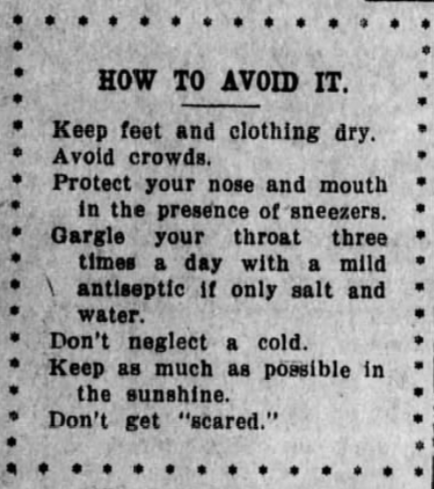
The importance of gauze masks in the anti-flu effort, especially for medical workers, was considered paramount. Leading the effort was the American Red Cross. The organization had grown from a little more than 100 local chapters at the beginning of World War I to almost 4,000 by its end. In October of 1918, the U.S. Surgeon General requested that the American Red Cross “assume charge of supplying all the needed nursing personnel and furnish emergency supplies.” The ARC mobilized nurses and mask-makers across the country, compelling women to get to work sewing gauze masks.
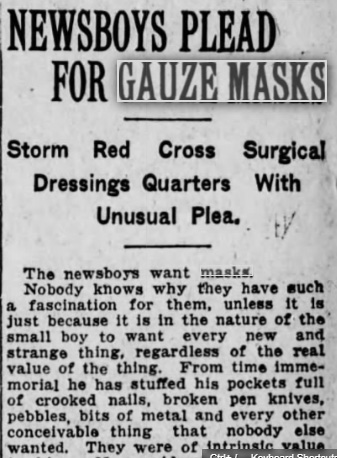
That month, cities began enforcing mask requirements. In Canada, railway passengers were refused admittance without masks. Iron River, Wisconsin — having experienced a bad outbreak — required mask-wearing in public. Tucson and San Diego passed ordinances mandating mask-wearing for store workers, and other cities did the same for barbers and nurses.
On October 17th, San Francisco closed churches, schools, theaters, “cabarets, and merry-go-rounds” to slow the spread of the virus. The city’s Board of Health, led by Dr. William C. Hassler, instituted a mask ordinance. The fine for disobedience was five dollars, which was then given to the Red Cross. Although several cities in California had such ordinances, the rule was never enforced statewide. In San Francisco, 100 people were arrested in October — reported in the news as “mask slackers” — and nine of them were sent to jail. In Stockton, California, one policeman apparently found his own father to be a mask slacker, and he arrested him, according to the Sacramento Bee.
Hassler assured his city that if everyone complied with the tight restrictions they would soon see influenza cases decline, after which they could go about business as usual. Oddly, the Health Officer also reportedly endorsed a massive sing-along in Golden Gate Park in mid-November, saying that as long as everyone wore their masks, it would “be in the nature of an experiment to see what effect music has on the influenza bacillus.” Hassler was also caught without a mask at a boxing match a few days later, maintaining that he must have moved it to smoke a cigar when the photo was snapped. Still, throughout November, San Francisco saw days with zero new cases of the disease, and, on November 21st, they unmasked at noon. Hassler declared the epidemic to be over.
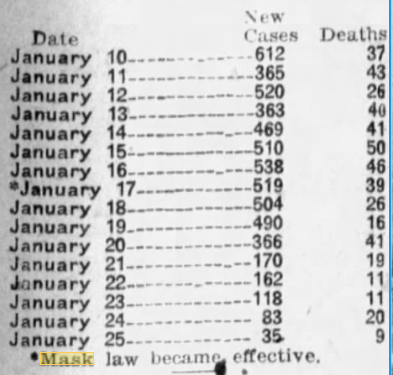
In December, however, cases in San Francisco started to creep back up, and Hassler called for everyone to mask up again. The Board of Supervisors voted against reinstating his ordinance though, on December 19th, one arguing that it was unfair “to the businessmen of San Francisco.” The meeting was described in the Sacramento Bee next to a public service announcement declaring “Spanish Influenza More Deadly than War.”
Going into 1919, cases in San Francisco continued to rise. On January 17th, the Board of Supervisors gave in to Hassler’s request, putting the mask requirement back into place. At that meeting, a San Franciscan announced she had organized an Anti-Mask League whose purpose was to “oppose by lawful means the compulsory wearing of masks.”
The Anti-Mask League met that weekend and declared themselves “Sanitary Spartacans.” They claimed the masks were useless and demanded the mayor repeal the ordinance requiring them. The group was led by a Board member and several doctors. The next week they held a meeting at Dreamland Rink, and 2,000 people showed up. They read bulletins from the State Board of Health “showing compulsory mask-wearing to be a failure” and urged attendees to “not submit to the domination of a few politicians and political doctors.” Simultaneously, the number of new cases in San Francisco was dropping each day since the second mask ordinance had been implemented. The League attended a Board meeting and hissed at supporters of the ordinance.
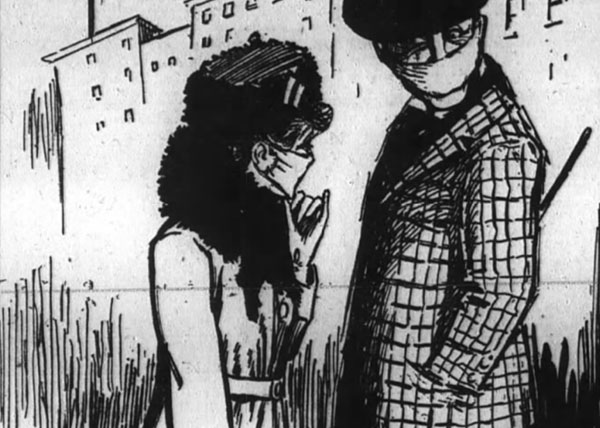
San Franciscans wrote into the Chronicle’s “People’s Safety Valve” section, deriding the ordinance and moaning that “the muzzle is a farce and an outrage against our liberties.” One man claimed his short beard was “the best kind of a mask, as it not only keeps the bronchial tubes in good condition, but it is better than any gauze mask for catching microbes.”
People complained that the Board ought to dedicate itself to cleaning up the city instead of implementing “autocratic” rules. The vocal opposers to the mask ordinance couldn’t believe that nine out of ten San Franciscans supported it, as was reported, since they claimed many people on the streets weren’t wearing them. The Chronicle even questioned the efficacy of face masks in an article, positing that more data would make clearer whether or not they were working.
San Francisco’s numbers continued to drop, though, and come February, the “gauze law” was scrapped. The Anti-Mask League presumably disbanded, having no more measures to oppose. People were free to roam the streets maskless without worrying about fines or arrest, and Hassler touted his rule for creating a 1000 percent decrease in cases over 11 days. Once again, he declared the end of the epidemic in San Francisco.
Featured image: Theater advertisement in the Sacramento Bee, January 1919
Become a Saturday Evening Post member and enjoy unlimited access. Subscribe now
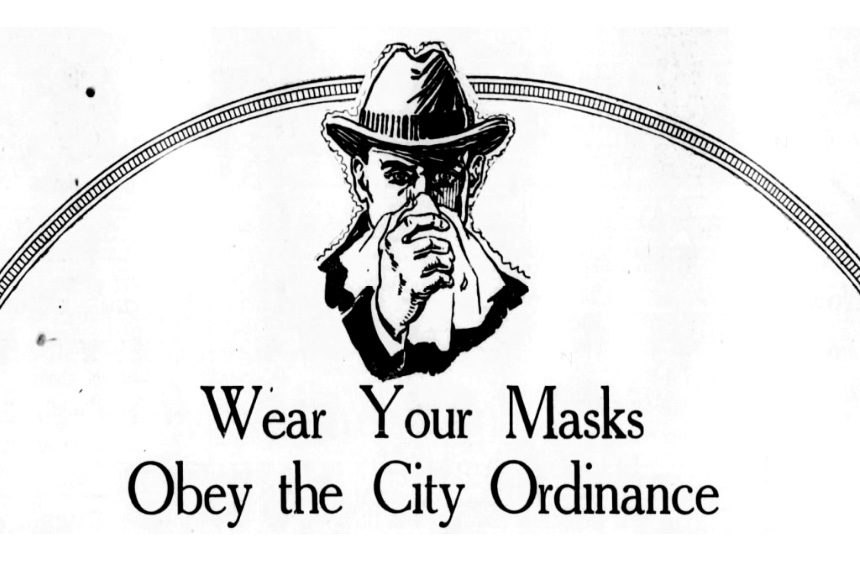



Comments
Bob McGown, As long as there is A reopening of a lock down there will be a resurge. Because of no herd immunity. These tests now cover colds, pneumonia, and any respiratory illness. Because they want the numbers outrageously high. And covid still Don’t touch the 50 million dead in 1918 and never will! Because its not a pandemic! Now 1918 was a pandemic. But I would like to see a news article from 1918 showing people being arrested for not wearing s mask. Not some news person just saying it.
Terry on May 9th you made outlandish and irresponsible comments that are truly false. If you don’t believe me ask the LNA who I work with whose husband died yesterday from COVID. Oh and he was a republican.
I agree with the implications of wearing masks in the past and present as a deterrent for the spread of disease. However, then as now, there are many who think we need to “get over” this! Diseases come and go, but one thing is for certain, unless we use common sense and follow the directives of experts Covid 19 will keep taking lives.
It would be helpful to learn whether mask-wearing OR social distancing alone was preferred.
History doesn’t repeat itself, but it rhymes.
Does Terry actually believe this pandemic is a liberal tactic?
Terry, Terry, Terry; please crawl out of that Trumpian cave you have isolated yourself in and see what the real world sees. If you remove your biased blinders you just might realize that we all are in this together.
Could we and YOU just put a sock in it??? This virus has become a nasty,disgusting political tactic by the libs. EVERYONE knows it and yet, some $%^&* seem to just go along with it and smirk. Overeacting has become the norm. Take back your lives before you lose all your rights!!! Get REAL.
This article is very timely in showing how wearing the face masks reduced the number of cases and deaths in the 1918-19 pandemic. We know that is has in the present one, and I personally think the public should continue to wear them for the foreseeable future.
When it comes to opening this country back up, it needs to be done in a gradual manner. If cases start spiking in whichever states that have, they may need to be shut down again. Regardless of that status, individuals need to continue wearing the masks, social distancing and whatever other guidelines the CDC and the experts recommend until the right vaccine becomes available and administered on a mass scale. Once the CDC gives the all clear, we’ll see. This virus is an invisible killer never to be taken lightly, ever.